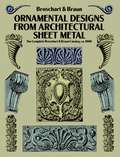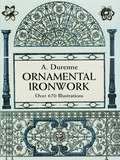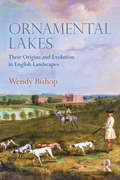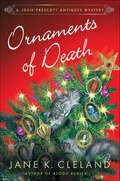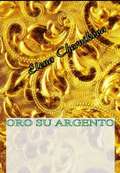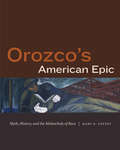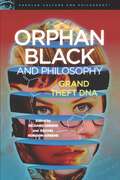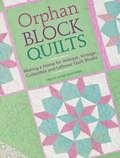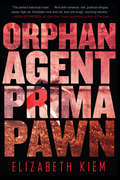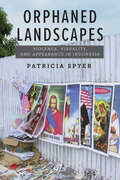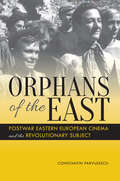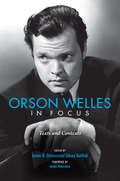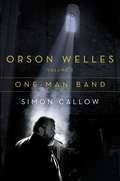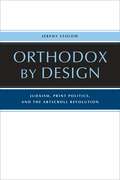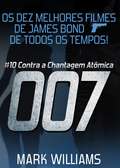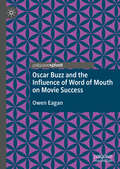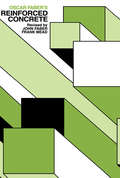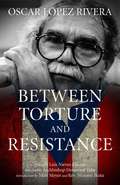- Table View
- List View
Ornamental Designs from Architectural Sheet Metal: The Complete Broschart & Braun Catalog, ca. 1900 (Dover Pictorial Archive)
by Wm. A. Braun Jacob BroschartA must for architectural historians, restoration specialists and vintage home enthusiasts: 1,095 late Victorian-era designs, superbly drawn or photographed, including egg and dart enrichments; bead, flute and ogee enrichments; drapery and drop ornaments; urns, vases and wreaths; eagles, lion heads and gargoyles; rosettes, ribbons, garlands and festoons; sunbursts, weather vanes and more.
Ornamental Ironwork: Over 670 Illustrations (Dover Pictorial Archive)
by A. DurenneFinely detailed illustrations, selected from rare turn-of-the-century sources, provide striking examples of decorative ironwork designed to embellish balconies, gates, window grilles, staircases, doorways, and other architectural features. A rich source of inspiration and elegant, royalty-free material for graphic artists, designers, and craftworkers.
Ornamental Lakes: Their Origins and Evolution in English Landscapes
by Wendy BishopOrnamental Lakes traces the history of lakes in England, from their appearance in the early eighteenth century, through their development in the 1750s, and finally to their decline in the nineteenth century. Aside from the natural lakes in the Lake District, the bodies of water we see in England today are man-made, primarily intended to ornament the landscapes of the upper classes. Through detailed research, author Wendy Bishop argues that, contrary to accepted thinking, the development of lakes led to the dissolution of formal landscapes rather than following changes in landscape design. Providing a comprehensive overview of lakes in England, including data on who made these lakes, how, and when, it additionally covers fishponds, water gardens, cascades and reservoirs. Richly illustrated and accompanied by case studies across the region, this book offers new insights in landscape history for students, researchers and those interested in how landscapes evolve.
Ornaments of Death (Josie Prescott Antiques Mysteries)
by Jane K. ClelandChristmas lights twinkle throughout the cozy coastal town of Rocky Point, New Hampshire, and Prescott's Antiques auction venue has been transformed into a winter wonderland for Josie Prescott's annual holiday party. Josie is especially excited this year-Ian Bennington, a recently discovered distant relative, will be joining the fun. Both Ian and Josie are, it seems, descended from Arabella Churchill, a 17th century royal mistress. The party is a success and Ian is a hit. It gives Josie an unexpected thrill to have family-and unexpected dread when he vanishes.Ian doesn't keep his dinner date with Josie's good friend, Lavinia, or his lunch date with her. Surely, he would have done so-if he could. Ian has given his daughter two priceless 17th century watercolor miniature portraits, one of Arabella and one of her lover, King James II, and they've gone missing, too. Knowing that after her nasty divorce, Lavinia is facing financial ruin, Josie can't help wondering if her friend is behind the theft-and Ian's disappearance.Determined to find Ian, Josie uses her knowledge of antiques to track the miniatures. In doing so, she learns the true meaning of Christmas-and the true meaning of family. Jane Cleland's Ornaments of Death is another masterful addition to the Josie Prescott series.
Oro de rey: Luis Miguel. La biografía
by Francisco Javier León HerreraEsta nueva biografía, impactante y reveladora como las anteriores, profundiza en los aspectos más importantes de su vida. Desnuda al ser humano que hay detrás de la leyenda, comparte las claves de su extenso legado musical lleno de anécdotas y complicadas decisiones, así como el bagaje existencial de amor, dolor, amistades, traiciones, heridas familiares, sueños rotos, amargura y esperanza. Tras sus dos bestsellers sobre el Sol: Luis Mi Rey, biografía autorizada por el artista que sirvió de base para la serie televisiva sobre su vida, y el más reciente, Luis Miguel: la historia, Javier León Herrera y Juan Manuel Navarro completan la trilogía sobre la existencia del cantante más amado en México, Argentina, Colombia, Estados Unidos, Chile, Puerto Rico, Perú, Bolivia, Brasil, España, Italia y Centroamérica. Oro de Rey ayuda a comprender más al artista adentrándose en el adulto lejos de la sombra -no del fantasma- de Luisito Rey. Gracias a sus confesiones y al testimonio de las personas que más lo conocen, los autores desvelan, con rigor y respeto, a un Luis Miguel más íntimo. En estas páginas se descubrirán los miedos, las luces y las sombras de un luchador que no deja de preguntarse por qué ha tenido que nadar tanto tiempo refugiado en un caparazón, a contracorriente de su propio espíritu y deseo, urgido de una catarsis definitiva que cierre círculos y sane su alma de tantas heridas. Los autores se adentran en aspectos determinantes de su vida: sus huellas de abandono, la ausencia materna, su hogar roto, los hermanos separados, sus éxitos y su estancamiento en la más reciente y profunda crisis en la que tocó fondo: el "Trienio Horribilis" de 2015 a 2017, y su resurgir en 2018, con los detalles de su renacer con el que celebró 50 años: sus bodas de oro con la vida. ¡Larga vida al Rey!
Oro su Argento
by Elena Chernikova Paola SambrunaUn racconto di vita reale, sul ritorno alla vita. L'anima che esce dal corpo, difficilmente riesce a ritornarvi.
Orozco's American Epic: Myth, History, and the Melancholy of Race
by Mary K. CoffeyBetween 1932 and 1934, José Clemente Orozco painted the twenty-four-panel mural cycle entitled The Epic of American Civilization in Dartmouth College's Baker-Berry Library. An artifact of Orozco's migration from Mexico to the United States, the Epic represents a turning point in his career, standing as the only fresco in which he explores both US-American and Mexican narratives of national history, progress, and identity. While his title invokes the heroic epic form, the mural indicts history as complicit in colonial violence. It questions the claims of Manifest Destiny in the United States and the Mexican desire to mend the wounds of conquest in pursuit of a postcolonial national project. In Orozco's American Epic Mary K. Coffey places Orozco in the context of his contemporaries, such as Diego Rivera and David Alfaro Siqueiros, and demonstrates the Epic's power as a melancholic critique of official indigenism, industrial progress, and Marxist messianism. In the process, Coffey finds within Orozco's work a call for justice that resonates with contemporary debates about race, immigration, borders, and nationality.
Orphan Black Classified Clone Reports: The Secret Files of Dr. Delphine Cormier
by Delphine CormierThe ultimate guide to all of the characters, conspiracies, and shadowy organizations in the smart, innovative BBC America television thriller Orphan Black.Designed to resemble the classified files and notes of Dr. Delphine Cormier, this in-world compendium chronicles the inner workings of the mysterious people and organizations at the heart of the acclaimed hit television series Orphan Black. A detailed and creative look at the thrilling international hit series, Orphan Black Classified Clone Report includes detailed dossiers of Sarah Manning, Felix Dawkins, and all of the show’s beloved characters; examines every twist and turn from season one to the present; provides exclusive information on the Dyad Institute, the Neolution clone program, and the notorious Proletheans; and features observations of the different clones from their monitors, classified intelligence, breakthroughs in Cosima’s research, and private journal entries chronicling Delphine’s experience with the clone club and her own complicated love for Cosima.Packed with exclusive concept art, photos, and ephemera, Orphan Black Classified Clone Report is an immersive reading experience and essential companion for fans of Orphan Black.
Orphan Black and Philosophy
by Richard Greene Rachel Robison-GreeneIn Orphan Black, several apparently unconnected women discover that they are exact physical doubles, that there are more of them out there, that they are all illegally produced clones, and that someone is having them killed. They find themselves in the midst of a secret and violent struggle between a fundamentalist religious group, a fanatical cult of superhuman biological enhancement, a clandestine department of the military, and a giant biotech corporation. Law enforcement is powerless and easily manipulated by these sinister forces. The clones are forced to form their own Clone Club, led by the resourceful Sarah Manning, to defend themselves against their numerous enemies and to find out exactly where they came from and why. <p><p> Orphan Black continually raises philosophical issues, as well as ethical and policy questions deserving philosophical analysis. What makes a person a unique individual? Why is it so important for us to know where we came from? Should we have a say in whether a clone is made of us? Is it immoral to generate clones with built-in health problems or personality defects - and if so, does that mean that producers of clones must practice eugenic selection? What light does the behavior of members of the Clone Club shed on the nature-nurture debate? Is it relevant that most are heterosexual, one is a lesbian, and one is a transgender male? <p> This TV show shows us problems of biotechnology which will soon be vital everyday issues. But what kind of a future faces us when human clones are commonplace? Will groups of human clones have a tight bond of solidarity making them a threat to democracy? If the world is going to be taken over by an evil conspiracy, would it better be a scientific cult like Neolution or a religious cult like the Prolethians? Should biotech corporations be able to own the copyright on human DNA sequences? What rules of morality apply when you can't trust the police and powerful groups are ready to murder you?
Orphan Block Quilts: Making a Home for Antique, Vintage, Collectible and Leftover Quilt Blocks
by Tricia Lynn MaloneyMake a home for your orphaned blocks!Orphaned blocks can find their way into any quilter's life. Whether they are leftover from an unfinished project, collectible blocks found at a garage sale, or even antique blocks discovered in your great-aunt's attic, Tricia Lynn Maloney will teach you how to care for your orphan blocks, and make a home for them.Orphan Block Quilts includes: *14 projects, with 11 variations. From full-size bed quilts to table runners, these projects incorporate blocks from the 1880s to the 1950s.*Instructions on caring for your orphan blocks. Find out about the common problems you might encounter with your orphans, and how to work with them.*Advice on designing a setting. Not only does Tricia provide guidance on creating companions blocks and finding companion fabric, she also offers insight on how she overcame the design challenges of each project. *The story behind each quilt. In addition to historical information about various fabrics and blocks, Tricia shares the stories of two of the blockmakers, providing a precious glimpse of the lives sewn into the seams of the blocks. If you don't have any orphan blocks, Tricia gives you advice on locating potential sources, whether from your own family or online. And it's easy to substitute brand-new blocks, and make a new quilt from the ground up. Check out the 11 variations in the book, where Tricia did just that! Whether your orphan blocks are antique, vintage, collectible or simply leftover from a recent project, you can sew the perfect setting that will let the blocks shine!
Orphan, Agent, Prima, Pawn
by Elizabeth KiemThe Bolshoi Saga: SvetlanaThe year is 1958, and sixteen-year-old Svetlana is stuck in a Moscow orphanage designated for the unwanted children of Stalin’s enemies. Ballet is her obsession and salvation, her only hope at shedding a tainted family past. When she is invited to join the Bolshoi Ballet—the crown jewel of Russian culture and the pride of the Soviet Union—her dreams appear to have been realized. But she quickly learns that nobody’s past or secrets are safe.The dreaded KGB knows about the mysterious trances Sveta has suffered, inexplicable episodes that seem to offer glimpses of the past. Some very powerful people believe Sveta is capable of serving the regime as more than a ballerina, and they wish to recruit her to spy on the West as part of the nascent Soviet psychic warfare program. If she is to erase the sins of her family, if she is to dance on the world stage for the Motherland—if she is to survive—she has no choice but to explore her other gift.
Orphaned Landscapes: Violence, Visuality, and Appearance in Indonesia
by Patricia SpyerLess than a year after the end of authoritarian rule in 1998, huge images of Jesus Christ and other Christian scenes proliferated on walls and billboards around a provincial town in eastern Indonesia where conflict had arisen between Muslims and Christians. A manifestation of the extreme perception that emerged amid uncertainty and the challenge to seeing brought on by urban warfare, the street paintings erected by Protestant motorbike-taxi drivers signaled a radical departure from the aniconic tradition of the old colonial church, a desire to be seen and recognized by political authorities from Jakarta to the UN and European Union, an aim to reinstate the Christian look of a city in the face of the country’s widespread islamicization, and an opening to a more intimate relationship to the divine through the bringing-into-vision of the Christian god.Stridently assertive, these affectively charged mediations of religion, masculinity, Christian privilege and subjectivity are among the myriad ephemera of war, from rumors, graffiti, incendiary pamphlets, and Video CDs, to Peace Provocateur text-messages and children’s reconciliation drawings. Orphaned Landscapes theorizes the production of monumental street art and other visual media as part of a wider work on appearance in which ordinary people, wittingly or unwittingly, refigure the aesthetic forms and sensory environment of their urban surroundings. The book offers a rich, nuanced account of a place in crisis, while also showing how the work on appearance, far from epiphenomenal, is inherent to sociopolitical change. Whether considering the emergence and disappearance of street art or the atmospherics and fog of war, Spyer demonstrates the importance of an attunement to elusive, ephemeral phenomena for their palpable and varying effects in the world.Orphaned Landscapes: Violence, Visuality, and Appearance in Indonesia is available from the publisher on an open-access basis.
Orphans of the East: Postwar Eastern European Cinema And The Revolutionary Subject
by Constantin ParvulescuUnlike the benevolent orphan found in Charlie Chaplin's The Kid or the sentimentalized figure of Little Orphan Annie, the orphan in postwar Eastern European cinema takes on a more politically fraught role, embodying the tensions of individuals struggling to recover from war and grappling with an unknown future under Soviet rule. By exploring films produced in postwar Hungary, the German Democratic Republic, Czechoslovakia, Romania, and Poland, Parvulescu traces the way in which cinema envisioned and debated the condition of the post-World War II subject and the "new man" of Soviet-style communism. In these films, the orphan becomes a cinematic trope that interrogates socialist visions of ideological institutionalization and re-education and stands as a silent critic of the system's shortcomings or as a resilient spirit who has resisted capture by the political apparatus of the new state.
Orson Welles in Focus: Texts and Contexts
by James Naremore Sidney Gottlieb James N. GilmoreThrough his radio and film works, such as The War of the Worlds and Citizen Kane, Orson Welles became a household name in the United States. Yet Welles’s multifaceted career went beyond these classic titles and included lesser-known but nonetheless important contributions to television, theater, newspaper columns, and political activism. Orson Welles in Focus: Texts and Contexts examines neglected areas of Welles’s work, shedding light on aspects of his art that have been eclipsed by a narrow focus on his films. By positioning Welles’s work during a critical period of his activity (the mid-1930s through the 1950s) in its larger cultural, political, aesthetic, and industrial contexts, the contributors to this volume examine how he participated in and helped to shape modern media. This exploration of Welles in his totality illuminates and expands our perception of his contributions that continue to resonate today.
Orson Welles in Focus: Texts and Contexts
by James N. Gilmore and Sidney Gottlieb“A wonderful and distinct addition to the Welles canon . . . these pieces explore key elements of Welles’s career, personality, and political beliefs.” —Library JournalThrough his radio and film works, such as The War of the Worlds and Citizen Kane, Orson Welles became a household name in the United States. Yet Welles’s multifaceted career went beyond these classic titles and included lesser-known but nonetheless important contributions to television, theater, newspaper columns, and political activism. Orson Welles in Focus: Texts and Contexts examines neglected areas of Welles’s work, shedding light on aspects of his art that have been eclipsed by a narrow focus on his films. By positioning Welles’s work during a critical period of his activity (the mid-1930s through the 1950s) in its larger cultural, political, aesthetic, and industrial contexts, the contributors to this volume examine how he participated in and helped to shape modern media. This exploration of Welles in his totalityilluminates and expands our perception of his contributions that continue to resonate today.“Anyone who thinks they know Welles will have their eyes opened [by this book].” —Paul Heyer, author of The Medium and the Magician“This is a fascinating collection, several of the contributions making the reader wish for more.” —Film International“A team of scholars has examined the many facets of Orson Welles’ amazing life—theatrical innovator, radio star, celebrated filmmaker, newspaper columnist and progressive activist.” —Wellesnet
Orson Welles's Last Movie: The Making of The Other Side of the Wind
by Josh KarpJournalist Josh Karp shines a spotlight on the making of The Other Side of the Wind—the final unfinished film from the auteur of Citizen Kane in Orson Welles’s Last Movie, the basis of Oscar-winning director Morgan Neville’s Netflix Original Documentary, They’ll Love Me When I’m Dead.In the summer of 1970, legendary but self-destructive director Orson Welles returned to Hollywood from years of self-imposed exile in Europe and decided it was time to make a comeback movie. Coincidentally, it was the story of a legendary self-destructive director who returns to Hollywood from years of self-imposed exile in Europe. Welles swore it wasn’t autobiographical.The Other Side of the Wind was supposed to take place during a single day, and Welles planned to shoot it in eight weeks. It took six years during his lifetime—only to be finally completed more than thirty years after his death by The Last Picture Show director Peter Bogdanovich, who narrates the film, and released by Netflix. Orson Welles’s Last Movie is a fast-paced, behind-the-scenes account of the bizarre, hilarious, and remarkable making of what has been called “the greatest home movie that no one has ever seen.” Funded by the shah of Iran’s brother-in-law, and based on a script that Welles rewrote every night for years, the film was a final attempt to one-up his own best work. It’s a production best encompassed by its star—the celebrated director of The Maltese Falcon, John Huston—who described the making of the film as “an adventure shared by desperate men that finally came to nothing.”
Orson Welles, Volume 3: One-Man Band
by Simon CallowThe third volume of Simon Callow's acclaimed Orson Welles biography, covering the period of his exile from America (1947-1964), when he produced some of his greatest works, including Touch of EvilIn One-Man Band, the third volume in his epic and all-inclusive four-volume survey of Orson Welles's life and work, the celebrated British actor Simon Callow again probes in comprehensive and penetrating detail into one of the most complex, contradictory artists of the twentieth century, whose glorious triumphs (and occasional spectacular failures) in film, radio, theater, and television introduced a radical and original approach that opened up new directions in the arts. This volume begins with Welles's self-exile from America, and his realization that he could function only to his own satisfaction as an independent film maker, a one-man band, in fact, which committed him to a perpetual cycle of money raising. By 1964, he had filmed Othello, which took three years to complete; Mr. Arkadin, the most puzzling film in his output; and a masterpiece in another genre, Touch of Evil, which marked his one return to Hollywood, and like all too many of his films was wrested from his grasp and reedited. Along the way he made inroads into the fledgling medium of television and a number of stage plays, of which his 1955 London Moby-Dick is considered by theater historians to be one of the seminal productions of the century. His private life was as spectacularly complex and dramatic as his professional life. The book reveals what it was like to be around Welles, and, with an intricacy and precision rarely attempted before, what it was like to be him, answering the riddle that has long fascinated film scholars and lovers alike: Whatever happened to Orson Welles?
Orthodox by Design: Judaism, Print Politics, and the ArtScroll Revolution
by Jeremy StolowOrthodox by Design, a groundbreaking exploration of religion and media, examines ArtScroll, the world's largest Orthodox Jewish publishing house, purveyor of handsomely designed editions of sacred texts and a major cultural force in contemporary Jewish public life. In the first in-depth study of the ArtScroll revolution, Jeremy Stolow traces the ubiquity of ArtScroll books in local retail markets, synagogues, libraries, and the lives of ordinary users. Synthesizing field research conducted in three local Jewish scenes where ArtScroll books have had an impact--Toronto, London, and New York--along with close readings of key ArtScroll texts, promotional materials, and the Jewish blogosphere, he shows how the use of these books reflects a broader cultural shift in the authority and public influence of Orthodox Judaism. Playing with the concept of design, Stolow's study also outlines a fresh theoretical approach to print culture and illuminates how evolving technologies, material forms, and styles of mediated communication contribute to new patterns of religious identification, practice, and power.Finalist for the National Jewish Book Award in the scholarship category, Jewish Book Council
Orzel: Scottsdale's Legendary Arabian Stallion (Sports)
by Stephanie J. Corum Tobi Lopez TaylorIn 1967, Scottsdale's longtime Arabian horse breeder Ed Tweed embarked on a mission to race the horses he bred. He imported a chestnut stallion from Poland named Orzel, or "Eagle" in English, that flew past competitors to become the first U.S. National Racing Champion. Among other wins in halter and performance, Orzel was the victor in the debut of the U.S. National Championship Ladies' Sidesaddle category, partnered with Tweed's granddaughter Shelley Groom Trevor. Thousands of fans visited the legendary performer in retirement at Brusally Ranch. Decades after Orzel's death, horses he sired continue his winning legacy. Author Tobi Lopez Taylor chronicles this triumphant story.
Os Dez Melhores Filmes De James Bond... De Todos Os Tempos! #10: 007 Contra a Chantagem Atômica
by Mark WilliamsOs Dez Melhores Filmes De James Bond... De Todos Os Tempos? Não poderia ser mais subjetivo que isto. Ou mais divertido! Venha se juntar ao autor de best-sellers internacionais Mark Williams em uma odisseia de James Bond enquanto ele explora o fenômeno James Bond, neste quinquagésimo aniversário do lançamento do filme de James Bond que entra em décimo lugar na lista: 007 Contra a Chantagem Atômica.
Osborn, The (Images of America)
by Andrew F. Horn Mark R. Zwerger Janet M. MalangOn opening day of The Osborn, Tuesday, April 21, 1908, 12 elderly gentlewomen stepped down from horse-drawn carriages and into a new life, a life that happened because of the vision of one remarkablewoman: Miriam Osborn. Seven years later, the first recorded history of the institution noted, ,"Every effort has been made to make this institution the finest in the world, and not only a fine institutionbut a real home.," Polished by the sands of time, the modern Osborn has sustained that world-class status as one of the nation,'s premier retirement communities. This volume celebrates those who preserved not so much a way of life but a philosophy of caring and a commitment to provide a real home that has endured for 100 years.
Oscar Buzz and the Influence of Word of Mouth on Movie Success
by Owen EaganThis book explores why word of mouth is the most important determinant of a movie’s success. Beginning with a discussion of the enduring appeal of movies, and why the box office has survived the disruption of television and will likely survive the disruption of streaming services, Owen Eagan goes on to discuss the unpredictable nature of movies and ways to mitigate their risk. His astute analysis sheds light on the role of film festivals, film critics, Oscar campaigns, and word of mouth in influencing a film's success. Eagan concludes with a summary of why word of mouth is the most influential among all the variables that affect a film’s outcome. Expertly synthesizing quantitative analyses of box office data with illuminating insights from industry experts, this concise and engaging book presents findings with important implications for scholars, industry insiders and marketing professionals alike.
Oscar Faber's Reinforced Concrete
by John G Faber F.H. MeadThis E. & F. N. Spon title is now distributed by Routledge in the US and Canada. It contains detailed coverage of the basic theory of reinforced and prestressed concrete, and demonstrates a wide range of practical applications. Examples and diagrams are used extensively throughout for ease of understanding.
Oscar Hammerstein II and the Invention of the Musical
by Laurie WinerA new look at artist Oscar Hammerstein II as a pivotal and underestimated force in the creation of modern American culture You know his work—Show Boat, Oklahoma!, Carousel, The King and I. But you don’t really know Oscar Hammerstein II, the man who, more than anyone else, invented the American musical. Among the most commercially successful artists of his time, he was a fighter for social justice who constantly prodded his audiences to be better than they were. Diving deep into Hammerstein’s life, examining his papers and his lyrics, critic Laurie Winer shows how he orchestrated a collective reimagining of America, urging it forward with a subtly progressive vision of the relationship between country and city, rich and poor, America and the rest of the world. His rejection of bitterness, his openness to strangers, and his optimistic humor shaped not only the musical but the American dream itself. His vision can continue to be a touchstone to this day.
Oscar López Rivera: Between Torture and Resistance
by Desmond Tutu Matt Meyer Osacar Lopez Rivera Luis Nieves Falcón Nozomi Ikuta<p>The life story of Puerto Rican freedom fighter and leader Oscar López Rivera, outlined in this book, is one of courage, valor, and sacrifice. In 1981, Oscar was convicted of seditious conspiracy and other crimes for which he is still imprisoned, making him the longest-held political prisoner in the world. This is the story of his fight for the political independence of Puerto Rico based on letters between him and the renowned lawyer, sociologist, educator, and activist Luis Nieves Falcón. <p>Also included is Oscar’s art, including photography and paintings created in his many years behind bars. Readers will explore his early life as a Latino child growing up in the small towns of Puerto Rico, following him as an adolescent as he and his family move to the big cities of the United States. After serving in Vietnam and earning a Bronze Star, Oscar returned home and worked to improve the quality of life for his people by becoming a community activist, which led to his underground life as a Puerto Rican Nationalist and his subsequent arrest. <p>With a vivid assessment of the ongoing colonial relationship between the United States and Puerto Rico, the book helps to illustrate the sad tale of largely unreported human rights abuses for political prisoners in the United States, but it is also a story of hope and his ongoing struggle for freedom for his people and himself—a hope that there is beauty and strength in resistance.</p>
